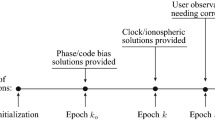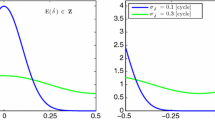Abstract
PPP-RTK extends the PPP concept by providing single-receiver users, next to orbits and clocks, also information about the satellite phase and code biases, thus enabling single-receiver ambiguity resolution. It is the goal of the present contribution to provide an analytical study of the quality of the PPP-RTK corrections as well as of their impact on the user ambiguity resolution performance. We consider the geometry-free and the geometry-based network derived corrections, as well as the impact of network ambiguity resolution on these corrections. Next to the insight that is provided by the analytical solutions, the closed form expressions of the variance matrices also demonstrate how the corrections depend on network parameters such as number of epochs, number of stations, number of satellites, and number of frequencies. As a result we are able to describe in a qualitative sense how the user ambiguity resolution performance is driven by the data from the different network scenarios.









Similar content being viewed by others
References
Baarda W (1973) S-transformations and criterion matrices, vol 5(1). Technical report, Netherlands Geodetic Commission, Publ. on Geodesy, New Series, Delft
Banville S, Collins P, Zhang W, Langley RB (2014) Global and regional ionospheric corrections for faster PPP convergence. Navigation 61(2):115–124
Bertiger W, Desai SD, Haines B, Harvey N, Moore AW, Owen S, Weiss JP (2010) Single receiver phase ambiguity resolution with GPS data. J Geod 84(5):327–337
Blewitt G (1989) Carrier phase ambiguity resolution for the global positioning system applied to geodetic baselines up to 2000 km. J Geophys Res 94(B8):10187–10203
Collins P (2008) Isolating and estimating undifferenced GPS integer ambiguities. In: Proceedings of ION NTM, pp 720–732
Ge M, Gendt G, Rothacher M, Shi C, Liu J (2008) Resolution of GPS carrier-phase ambiguities in precise point positioning (PPP) with daily observations. J Geod 82(7):389–399
Geng J, Bock Y (2013) Triple-frequency GPS precise point positioning with rapid ambiguity resolution. J Geod 87(5):449–460
Geng J, Shi C, Ge M, Dodson AH, Lou Y, Zhao Q, Liu J (2012) Improving the estimation of fractional-cycle biases for ambiguity resolution in precise point positioning. J Geod 86(8):579–589
Grejner-Brzezinska DA, Wielgosz P, Kashani I, Smith DA, Spencer PS, Robertson DS, Mader GL et al (2004) An analysis of the effects of different network-based ionosphere estimation models on rover positioning accuracy. J GPS 3(1–2):115–131
Grejner-Brzezinska DA, Kashani I, Wielgosz P, Smith DA, Spencer PS, Robertson DS, Mader GL (2007) Efficiency and reliability of ambiguity resolution in network-based real-time kinematic GPS. J Surv Eng 133(2):56–65
Henderson HV, Pukelsheim F, Searle SR (1983) On the history of the Kronecker product. Linear Multilinear Algebra 14(2):113–120
Heroux P, Kouba J (1995) GPS precise point positioning with a difference. In: Paper presented at geomatics 95, Ottawa, ON, Canada, 13–15 June
Hofmann-Wellenhof B, Lichtenegger H, Wasle E (2008) GNSS: global navigation satellite systems: GPS, glonass, galileo, and more. Springer, New York
Jonkman N, Teunissen P, Joosten P, Odijk D (2000) GNSS long baseline ambiguity resolution: impact of a third navigation frequency. In: Geodesy beyond 2000, IAG symposium, vol 121, pp 349–354
Lannes A, Prieur JL (2013) Calibration of the clock-phase biases of GNSS networks: the closure-ambiguity approach. J Geod 87(8):709–731
Lannes A, Teunissen PJG (2011) GNSS algebraic structures. J Geod 85(5):273–290
Laurichesse D, Mercier F (2007) Integer ambiguity resolution on undifferenced GPS phase measurements and its application to PPP. In: Proceedings of the 20th international technical meeting of the Satellite Division of The Institute of Navigation (ION GNSS 2007), pp 839–848
Li B, Shen Y, Feng Y, Gao W, Yang L (2014) GNSS ambiguity resolution with controllable failure rate for long baseline network RTK. J Geod 88(2):99–112
Li X, Zhang X (2012) Improving the estimation of uncalibrated fractional phase offsets for PPP ambiguity resolution. J Navig 65(03):513–529
Li X, Ge M, Zhang H, Wickert J (2013) A method for improving uncalibrated phase delay estimation and ambiguity-fixing in real-time precise point positioning. J Geod 87(5):405–416
Loyer S, Perosanz F, Mercier F, Capdeville H, Marty JC (2012) Zero-difference GPS ambiguity resolution at CNES–CLS IGS Analysis Center. J Geod 86(11):991–1003
Mervart L, Lukes Z, Rocken C, Iwabuchi T (2008) Precise Point Positioning with ambiguity resolution in real-time. In: Proceedings of ION GNSS, pp 397–405
Mervart L, Rocken C, Iwabuchi T, Lukes Z, Kanzaki M (2013) Precise point positioning with fast ambiguity resolution-prerequisites, algorithms and performance. In: Proceedings of ION GNSS, pp 1176–1185
Odijk D (2002) Fast precise GPS positioning in the presence of ionospheric delays, vol 52. Ph.D. thesis, Delft University of Technology, Publication on Geodesy, Netherlands, Geodetic Commission, Delft
Odijk D, Teunissen PJG (2008) ADOP in closed form for a hierarchy of multi-frequency single-baseline GNSS models. J Geod 82(8):473–492
Odijk D, Teunissen PJG, Zhang B (2012) Single-frequency integer ambiguity resolution enabled GPS precise point positioning. J Surv Eng 138(4):193–202
Odijk D, Arora BS, Teunissen PJG (2014) Predicting the success rate of long-baseline GPS + Galileo (partial) ambiguity resolution. J Navig 67(3):385–401
Schaer S (1999) Mapping and predicting the Earth’s ionosphere using the global positioning system. Ph.D. thesis, University of Bern, Bern, Switzerland
Teunissen P, Jonkman N, Joosten P, Tiberius C (2000) Long baseline 3 frequency differential GNSS. In: Position location and navigation symposium, IEEE 2000, San Diego, CA, pp 7–14. doi: 10.1109/PLANS.2000.838277
Teunissen PTG (1985) Generalized inverses, adjustment, the datum problem and S-transformations. In: Grafarend EW, Sanso F (eds) Optimization and design of geodetic networks. Springer, Berlin
Teunissen PJG (1997a) A canonical theory for short GPS baselines. Part I: The baseline precision. J Geod 71(6):320–336
Teunissen PJG (1997b) A canonical theory for short GPS baselines. Part IV: Precision versus reliability. J Geod 71(9):513–525
Teunissen PJG (2000) Adjustment theory: an Introduction. Delft University Press, Series on Mathematical Geodesy and Positioning
Teunissen PJG, Khodabandeh A (2014) Do GNSS parameters always benefit from integer ambiguity resolution? a PPP-RTK network scenario. In: Proceedings of ION GNSS+. Tampa, Florida, pp 590–600
Teunissen PJG, Khodabandeh A (2015) Review and principles of PPP-RTK methods. J Geod 89(3):217–240
Teunissen PJG, Kleusberg A (1998) GPS for geodesy, 2nd edn. Springer, Berlin
Teunissen PJG, Odijk D, Zhang B (2010) PPP-RTK: results of CORS network-based PPP with integer ambiguity resolution. J Aeronaut Astronaut Aviat 42(4):223–229
Verhagen S (2002) Studying the performance of global navigation satellite systems: a new software tool. GPS world 13(6):60–65
Wielgosz P, Krankowski A, Sieradzki R, Grejner-Brzezinska DA (2008) Application of predictive regional ionosphere model to medium range RTK positioning. Acta Geophys 56(4):1147–1161
Wubbena G, Schmitz M, Bagg A (2005) PPP-RTK: precise point positioning using state-space representation in RTK networks. In: Proceedings of ION GNSS, pp 13–16
Yu X, Zhang X, Liu J, Shi J, Cai C, Gao Y (2011) Performance assessment of long-baseline integer ambiguity resolution with different observation models. In: Proceedings of ION GNSS, Portland, pp 688–698
Zhang B, Teunissen PJG, Odijk D (2011) A novel un-differenced PPP-RTK concept. J Navig 64(S1):S180–S191
Zhang X, Li P, Guo F (2013) Ambiguity resolution in precise point positioning with hourly data for global single receiver. Adv Space Res 51(1):153–161
Zumberge JF, Heflin MB, Jefferson DC, Watkins MM, Webb FH (1997) Precise point positioning for the efficient and robust analysis of GPS data from large networks. J Geophys Res 102:5005–5017
Acknowledgments
This work has been done in the context of the Positioning Program Project 1.19 “Multi-GNSS PPP-RTK Network Processing” of the Cooperative Research Centre for Spatial Information (CRC-SI). The second author is the recipient of an Australian Research Council (ARC) Federation Fellowship (Project Number FF0883188). All this support is gratefully acknowledged.
Author information
Authors and Affiliations
Corresponding author
Appendix
Appendix
Proof of Theorem 1
To prove (51), we apply the least-squares conditional adjustment (Teunissen 2000) to the single-station correction ‘\({\mathrm{I}}\)’. Given the GF ambiguity-float network redundancy (Table 3), the following uncorrelated sets of misclosures are formed
\(l=1,\ldots ,n\). The first set of misclosures t is due to the fact that all single-station solutions of the estimable code biases \(\tilde{d}^{ps}\) have the same mean. The n sets of misclosures \(t_l\) are due to the fact that all single-station solutions of the estimable ambiguities \(\tilde{a}_l^{ps}\) and code biases \(\tilde{d}^{ps}\) are assumed constant over k epochs. According to the least-squares conditional adjustment, the GF ambiguity-float network correction (51) is obtained as
This, together with the following equalities
completes the proof. \(\square \)
Proof of Theorem 2
The proof goes along the same lines as the proof of Theorem 1. The GF ambiguity-fixed network correction (57) is obtained through replacing the role of the misclosure vector t in (100) by its higher-dimension counterpart (cf. Table 3)
together with the equality
\(\square \)
Proof of Theorem 3
We apply the least-squares conditional adjustment to the GF ambiguity-float network correction (51). Given the extra redundancy by the geometry-based network model (Table 6), the following sets of misclosures are formed
\(l=2,\ldots ,n\). The first set of misclosures \(t_g\) is due to the ‘geometry-parametrization’ of (72). The \((n-1)\) sets of misclosures \(t_{g_{1l}}\) are due to the fact that the relative position increments and ZTDs \(({\varDelta } x_l - {\varDelta } x_1)\) are assumed constant over k epochs. According to the least-squares conditional adjustment, the GB ambiguity-float network correction (75) is obtained as
with \(y=[\hat{\tilde{c}}_{\phi , \scriptscriptstyle \mathrm{GF}}^T (i),\hat{\tilde{c}}_{p, \scriptscriptstyle \mathrm{GF}}^T (i)]^T\) and \(t_{g_L}=[t_{g_{12}}^T,\ldots ,t_{g_{1n}}^T]^T\). Equation (75) follows then by substituting
into (105). \(\square \)
Proof of Theorem 4
We apply the least-squares conditional adjustment to the GF ambiguity-fixed network correction (57), on the basis of the extra geometry-based misclosures given in (104). The GB ambiguity-fixed network correction (81) follows then through replacing the role of y in (105) by \(\tilde{y}=[\check{\tilde{c}}_{\phi , \scriptscriptstyle \mathrm{GF}}^T (i),\check{\tilde{c}}_{p, \scriptscriptstyle \mathrm{GF}}^T (i)]^T\), together with the equalities
\(\square \)
Rights and permissions
About this article
Cite this article
Khodabandeh, A., Teunissen, P.J.G. An analytical study of PPP-RTK corrections: precision, correlation and user-impact. J Geod 89, 1109–1132 (2015). https://doi.org/10.1007/s00190-015-0838-9
Received:
Accepted:
Published:
Issue Date:
DOI: https://doi.org/10.1007/s00190-015-0838-9




